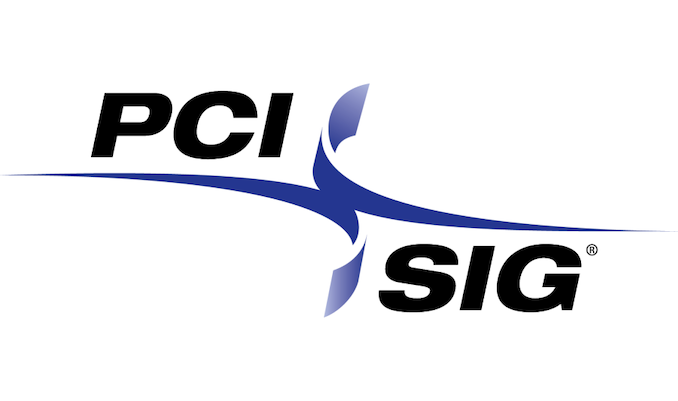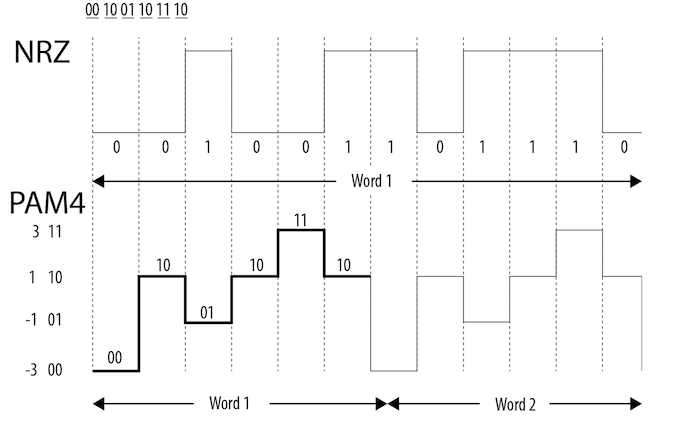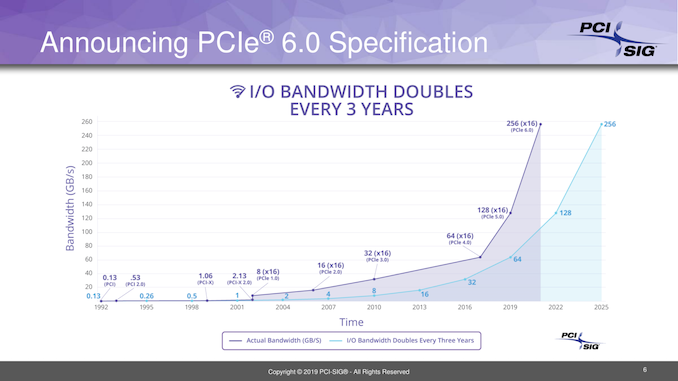PCI Express Bandwidth to Be Doubled Again: PCIe 6.0 Announced, Spec to Land in 2021
by Ryan Smith on June 18, 2019 5:00 PM EST
When the PCI Special Interest Group (PCI-SIG) first announced PCIe 4.0 a few years back, the group made it clear that they were not just going to make up for lost time after PCIe 3.0, but that they were going to accelerate their development schedule to beat their old cadence. Since then the group has launched the final versions of the 4.0 and 5.0 specifications, and now with 5.0 only weeks old, the group is announcing today that they are already hard at work on the next version of the PCIe specification, PCIe 6.0. True to PCIe development iteration, the forthcoming standard will once again double the bandwidth of a PCIe slot – a x16 slot will now be able to hit a staggering 128GB/sec – with the group expecting to finalize the standard in 2021.
As with the PCIe iterations before it, the impetus for PCIe 6.0 is simple: hardware vendors are always in need of more bandwidth, and the PCI-SIG is looking to stay ahead of the curve by providing timely increases in bandwidth. Furthermore in the last few years their efforts have taken on an increased level of importance as well, as other major interconnect standards are building off of PCIe. CCIX, Intel’s CXL, and other interfaces have all extended PCIe, and will in turn benefit from PCIe improvements. So PCIe speed boosts serve as the core of building ever-faster (and more interconnected) systems.
PCIe 6.0, in turn, is easily the most important/most disruptive update to the PCIe standard since PCIe 3.0 almost a decade ago. To be sure, PCIe 6.0 remains backwards compatible with the 5 versions that have preceded it, and PCIe slots aren’t going anywhere. But with PCIe 4.0 & 5.0 already resulting in very tight signal requirements that have resulted in ever shorter trace length limits, simply doubling the transfer rate yet again isn’t necessarily the best way to go. Instead, the PCI-SIG is going to upend the signaling technology entirely, moving from the Non-Return-to-Zero (NRZ) tech used since the beginning, and to Pulse-Amplitude Modulation 4 (PAM4).
At a very high level, what PAM4 does versus NRZ is to take a page from the MLC NAND playbook, and double the number of electrical states a single cell (or in this case, transmission) will hold. Rather than traditional 0/1 high/low signaling, PAM4 uses 4 signal levels, so that a signal can encode for four possible two-bit patterns: 00/01/10/11. This allows PAM4 to carry twice as much data as NRZ without having to double the transmission bandwidth, which for PCIe 6.0 would have resulted in a frequency around 30GHz(!).

NRZ vs. PAM4 (Base Diagram Courtesy Intel)
PAM4 itself is not a new technology, but up until now it’s been the domain of ultra-high-end networking standards like 200G Ethernet, where the amount of space available for more physical channels is even more limited. As a result, the industry already has a few years of experience working with the signaling standard, and with their own bandwidth needs continuing to grow, the PCI-SIG has decided to bring it inside the chassis by basing the next generation of PCIe upon it.
The tradeoff for using PAM4 is of course cost. Even with its greater bandwidth per Hz, PAM4 currently costs more to implement at pretty much every level, from the PHY to the physical layer. Which is why it hasn’t taken the world by storm, and why NRZ continues to be used elsewhere. The sheer mass deployment scale of PCIe will of course help a lot here – economies of scale still count for a lot – but it will be interesting to see where things stand in a few years once PCIe 6.0 is in the middle of ramping up.
Meanwhile, not unlike the MLC NAND in my earlier analogy, because of the additional signal states a PAM4 signal itself is more fragile than a NRZ signal. And this means that along with PAM4, for the first time in PCIe’s history the standard is also getting Forward Error Correction (FEC). Living up to its name, Forward Error Correction is a means of correcting signal errors in a link by supplying a constant stream of error correction data, and it’s already commonly used in situations where data integrity is critical and there’s no time for a retransmission (such as DisplayPort 1.4 w/DSC). While FEC hasn’t been necessary for PCIe until now, PAM4’s fragility is going to change that. The inclusion of FEC shouldn’t make a noticeable difference to end-users, but for the PCI-SIG it’s another design requirement to contend with. In particular, the group needs to make sure that their FEC implementation is low-latency while still being appropriately robust, as PCIe users won’t want a significant increase in PCIe’s latency.
The upshot of the switch to PAM4 then is that by increasing the amount of data transmitted without increasing the frequency, the signal loss requirements won’t go up. PCIe 6.0 will have the same 36dB loss as PCIe 5.0, meaning that while trace lengths aren’t officially defined by the standard, a PCIe 6.0 link should be able to reach just as far as a PCIe 5.0 link. Which, coming from PCIe 5.0, is no doubt a relief to vendors and engineers alike.
Even with these changes, however, as previously mentioned PCIe 6.0 is fully backwards compatible with earlier standards, and this will go for both hosts and peripherals. This means that to a certain extent, hardware designers are essentially going to be implementing PCIe twice: once for NRZ, and again for PAM4. This will be handled at the PHY level, and while it’s not a true doubling of logic (what is NRZ but PAM4 with half as many signal levels?), it does mean that backwards compatibility is a bit more work this time around. Though discussing the matter in today’s press conference, it doesn’t sound like the PCI-SIG is terribly concerned about the challenges there, as PHY designers have proven quite capable (e.g. Ethernet).
| PCI Express Bandwidth (Full Duplex) |
||||||||
| Slot Width | PCIe 1.0 (2003) |
PCIe 2.0 (2007) |
PCIe 3.0 (2010) |
PCIe 4.0 (2017) |
PCIe 5.0 (2019) |
PCIe 6.0 (2021) |
||
| x1 | 0.25GB/sec | 0.5GB/sec | ~1GB/sec | ~2GB/sec | ~4GB/sec | ~8GB/sec | ||
| x2 | 0.5GB/sec | 1GB/sec | ~2GB/sec | ~4GB/sec | ~8GB/sec | ~16GB/sec | ||
| x4 | 1GB/sec | 2GB/sec | ~4GB/sec | ~8GB/sec | ~16GB/sec | ~32GB/sec | ||
| x8 | 2GB/sec | 4GB/sec | ~8GB/sec | ~16GB/sec | ~32GB/sec | ~64GB/sec | ||
| x16 | 4GB/sec | 8GB/sec | ~16GB/sec | ~32GB/sec | ~64GB/sec | ~128GB/sec | ||
Putting all of this in practical terms then, PCIe 6.0 will be able to reach anywhere between ~8GB/sec for a x1 slot up to ~128GB/sec for a x16 slot (e.g. accelerator/video card). For comparison’s sake, 8GB/sec is as much bandwidth as a PCIe 2.0 x16 slot, so over the last decade and a half, the number of lanes required to deliver that kind of bandwidth has been cut to 1/16th the original amount.
Overall, the PCI-SIG has set a rather aggressive schedule for this standard: the group has already been working on it, and would like to finalize the standard in 2021, two years from now. This would mean that the PCI-SIG will have improved PCIe’s bandwidth by eight-fold in a five-year period, going from PCIe 3.0 and its 8 GT/sec rate in 2016 to 4.0 and 16 GT/sec in 2017, 5.0 and 32 GT/sec in 2019, and finally 6.0 and 64 GT/sec in 2021. Which would be roughly half the time it has taken to get a similar increase going from PCIe 1.0 to 4.0.
As for end users and general availability of PCIe 6.0 products, while the PCI-SIG officially defers to the hardware vendors here, the launch cycles of PCIe 4.0 and 5.0 have been very similar, so PCIe 6.0 will likely follow in those same footsteps. 4.0, which was finalized in 2017, is just now showing up in mass market hardware in 2019, and meanwhile Intel has already committed to PCIe 5.0-capable CPUs in 2021. So we may see PCIe 6.0 hardware as soon as 2023, assuming development stays on track and hardware vendors move just as quickly to implement it as they have on earlier standards. Though for client/consumer use, it bears pointing out that with the rapid development pace for PCIe – and the higher costs that PAM4 will incur – just because the PCI-SIG develops 6.0 it doesn't mean it will show up in client decides any time soon; economics and bandwidth needs will drive that decision.
Speaking of which, as part of today’s press conference the group also gave a quick update on PCIe compliance testing and hardware rollouts. PCIe 4.0 compliance testing will finally kick off in August of this year, which should further accelerate 4.0 adoption and hardware support. Meanwhile PCIe 5.0 compliance testing is still under development, and like 4.0, once 5.0 compliance testing becomes available it should open the flood gates to much faster adoption there as well.
Source: PCI-SIG


















119 Comments
View All Comments
PeachNCream - Tuesday, June 18, 2019 - link
Will need 2 tiny, useless cooling fans instead of just one! Double the chances of failure after 6 months of occasional use!mode_13h - Tuesday, June 18, 2019 - link
You're assuming the lane count stays constant. I think the mainstream CPUs, chipsets, and peripherals will start dropping lane counts, by the time they adopt PCIe 5.0.shabby - Tuesday, June 18, 2019 - link
Don't give intel any ideas, last thing we need is less lanes.Amd on the other hand... more lanes for everyone!
mode_13h - Wednesday, June 19, 2019 - link
Well, it's a legit way to counter the increased power consumption, also while cutting costs.Honestly, do you think we actually need x4 NVMe @ PCIe 5.0+? I can't see the use case for that, on the desktop. And any drives that can exceed even what PCIe 4.0 provides are going to run too hot.
Same with GPUs. I don't see what's going to change that's going to deliver a measurable benefit for *most* GPUs at > x8 @ PCIe 4.0. You can already find some entry-level GPUs with x8 interfaces - a trend I see continuing to move up the range. By PCIe 5.0, some cards & mobos might even drop the x16 connector.
And 10 Gig NICs will do fine at just x1 @ PCIe 4.0.
So, why do you really need so many lanes, in a desktop? It seems to me that this push for faster connectivity is driven almost 100% by cloud & HPC.
shabby - Wednesday, June 19, 2019 - link
With gpus no, but with nvme drives yes. Look how long we've been stuck at 3.5GB/sec with nvme pcie3 drives. As soon as pcie4 came out we're upto 4.8GB/sec already. Give them available bandwidth and they'll use it up.ats - Wednesday, June 19, 2019 - link
You can't buy a NVMe drive of any type that can hit 3.5GB/s in any meaningful workload. PCIe 4.0 won't change that. You'll just get some bigger more useless marketing numbers while actual performance remains pretty much unchanged. You can also take something like a 970pro and run it half width or data rate and not notice any actual performance difference.AKA sequential transfer rates are useless.
mode_13h - Wednesday, June 19, 2019 - link
But they'll use it up for *what*? Why do desktop PCs need more than the ~8 GB/sec they'll get with x4 PCIe 4.0?On a workstation, I could imagine a need for paging in a multi-TB dataset. But I'm specifically talking about mainstream desktop CPUs & chipsets.
DanNeely - Tuesday, June 18, 2019 - link
Other than the fact that it's going to complicate my when to build a new PC decision this is great news.My nominal plan was to replace my 4790K in 2021/2 at 6/7 years old. At that point I was expecting to jump on the DDR5 bandwagon and either have PCIe5 for future proofing or have it be reasonably clear that it's signalling is too expensive to implement on consumer hardware and that 4.0 would be top of the line for anything I'd need for a reasonably long time.
Waiting for PCIe6 would push things out to to the 2023/4 timeframe, by the end of which my (jan 2015) system would be pushing a decade which is a bit nervous making in terms of reliability even if 4 physical cores haven't become a high end gaming bottleneck yet.
mode_13h - Tuesday, June 18, 2019 - link
> My nominal plan was to replace my 4790K in 2021/2 at 6/7 years old.The best time to upgrade is when you're starting to be limited by your current hardware. Beyond that, I'd say only delay if a new standard is right around the corner, at the point when you're almost ready to pull the trigger.
PCIe 3.0 still isn't really a bottleneck, in PCs. I think PCIe 4.0 will be fine for quite a while. As I said above, I expect the main difference with PCIe 5.0 is that mainstream CPUs, chipsets, and peripherals will start cutting lanes. This will reduce costs and power consumption, without much impact on performance.
DanNeely - Tuesday, June 18, 2019 - link
my nominal year 6/7 timeframe is because I want to replace my system on my own time not in a frantic rush because something failed leaving me down. That means I want to replace it before it gets old enough to start climbing the back side of the reliability bathtub curve.